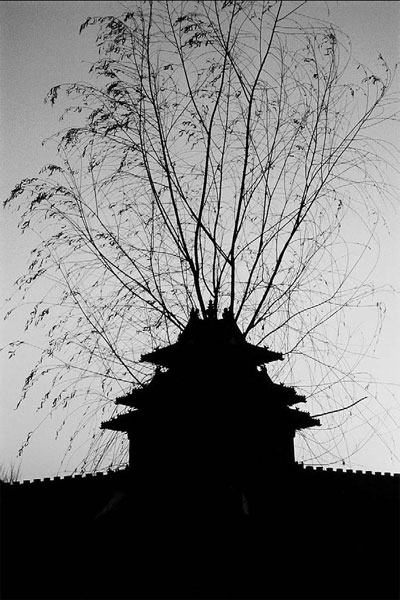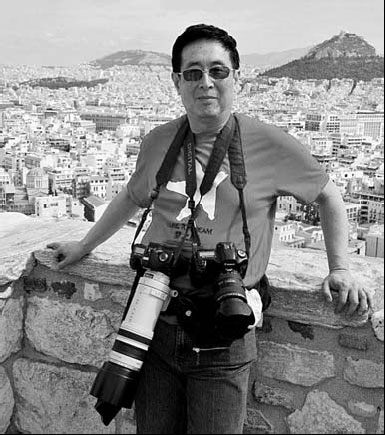Life and Leisure
Focusing on beauty
By Cheng Yingqi (China Daily)
Updated: 2010-09-13 15:44
 |
Large Medium Small |
|
One of Li's pictures features a tower in one corner of the Forbidden City with a willow tree behind it. Photos Provided to China Daily |
|
Photographer Li Shaobai has spent 17 years capturing the magnificence of the Forbidden City and the Great Wall with his camera. |
After shooting the Forbidden City for the last 17 years, celebrity photographer Li Shaobai has turned his lens on women. Cheng Yingqi reports
How is the Forbidden City like a beautiful woman? Celebrity photographer Li Shaobai, for whom the Ming Dynasty imperial palace courtyard has been a 17-year-long obsession, says he is attracted to both for their "invisible beauty".
Li, 68, has produced eight photo albums, capturing the magnificence of the Forbidden City and the Great Wall. Lauded widely for his work at home and in France, Japan, Germany, Switzerland and the US - particularly for an album named The Invisible Palace, featuring 10 years of work - Li's forthcoming project focuses on the mystical nature of the fair sex.
"I have been working on the book for years. The title, The Invisible Beauty, best explains my understanding of the theme," Li says.
The high-profile photographer is also a professor with the College of International Education of the Minzu University of China and serves on the editorial board of several magazines in China.
His style is notably unorthodox. Sometimes photos taken by him highlight small details of the gigantic ancient structures that often go unnoticed by most visitors, while others are taken from angles that few would ever think of.
For example, in one picture, Li made use of insufficient light at dusk to overlap a tower in one corner of the Forbidden City with the black shadow of a willow that was 100 meters away from the tower. The image turned out to look like a monster stretching across hundreds of feet. It was both impressive and a little scary.
"The tower had stood there for 500 years, and the tree on the other side for several decades, but no one had ever thought of putting them together in the same frame," Li says.
He says each snap is a one-off attempt and cannot be replicated, even by him.
"That's why I said the Forbidden City was 'invisible'. Although it is over there and anybody can visit it, not everyone observes the same (elements of) magnificence of the palace," Li says.
"I am fascinated with the camera for precisely the same reason," he says. "The camera limits one's view, however, at the same time, it gives one a chance for individual maneuvering, (the scope of) which is infinite."
He did not fall in love with the imperial palace at first sight. When he saw it the first time at the age of 10, Li was slightly put off because to him it represented the might of ancient empires.
Early in his career, between 1982 and 1992, Li was shooting women from showbiz. He wanted to be a top glamor photographer and had taken thousands of photos of famous movie stars like Gong Li and Chen Xiaoxu.
The turning point came when he heard a fellow photographer say, "Li Shaobai would forget how to press the shutter if the camera weren't aimed at a woman's leg."
The man who made the snide remark specialized in photographing architecture. Li decided to beat him at his own game, "to prove that a real artist could make magic happen, whatever the subject".
Once he had decided on his subject, Li scanned every inch of the Forbidden City, looking out for less obvious elements. His conviction was that the palace could "present photographers with anything they wanted to see, if they knew how to find the right angle".
Li shot the red walls, glazed tiles, gray floors and white marble balustrades of the old imperial palace. He was going there every week. Soon he developed a bond with the ancient architecture.
"People say my Forbidden City photos embody humanistic meaning in them, but I do not think so. It's the pure pursuit of the magnificent beauty of the gorgeous palace, without being driven by a sense of morality or ideology," Li says.
Li's new book on the feminine mystique draws heavily on his experience of exploring the palace architecture.
"In Invisible Beauty, I won't necessarily aim at traditional beauties," Li says. "I will try to catch ordinary women in their most beautiful moment".
"A good picture," Li adds, "is not only about finding odd angles, using expensive cameras or capturing heart-warming images. The most important point is to not miss the beauty, to not let it remain invisible."

